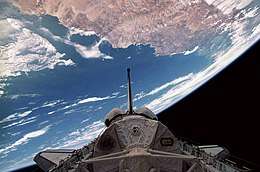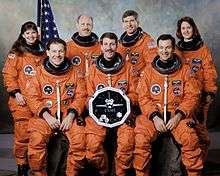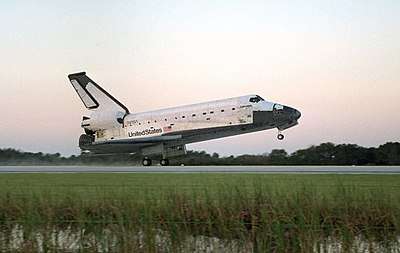STS-73
STS-73 was a Space Shuttle program mission, during October–November 1995, on board the Space Shuttle Columbia. The mission was the second mission for the United States Microgravity Laboratory. The crew, who spent 16 days in space, were broken up into 2 teams, the red team and the blue team. The mission also included several Detailed Test Objectives or DTO's.
 Spacelab Module LM1 in Columbia's payload bay, serving as the United States Microgravity Laboratory | |
| Mission type | Microgravity research |
|---|---|
| Operator | NASA |
| COSPAR ID | 1995-056A |
| SATCAT no. | 23688 |
| Mission duration | 15 days, 21 hours, 53 minutes, 16 seconds |
| Distance travelled | 10,600,000 kilometres (6,600,000 mi) |
| Orbits completed | 255 |
| Spacecraft properties | |
| Spacecraft | Space Shuttle Columbia |
| Payload mass | 15,250 kilograms (33,620 lb) |
| Crew | |
| Crew size | 7 |
| Members |
|
| Start of mission | |
| Launch date | 20 October 1995, 13:53:00 UTC |
| Launch site | Kennedy LC-39B |
| End of mission | |
| Landing date | 5 November 1995, 11:45:21 UTC |
| Landing site | Kennedy SLF Runway 33 |
| Orbital parameters | |
| Reference system | Geocentric |
| Regime | Low Earth |
| Perigee altitude | 241 kilometres (150 mi) |
| Apogee altitude | 241 kilometres (150 mi) |
| Inclination | 39.0 degrees |
| Period | 89.7 min |
  Left to right - Seated: Sacco, Rominger, Lopez-Alegria; Standing: Coleman, Bowersox, Leslie, Thornton | |
Crew
| Position | Astronaut | |
|---|---|---|
| Commander | Kenneth D. Bowersox Third spaceflight | |
| Pilot | Kent V. Rominger First spaceflight | |
| Mission Specialist 1 | Catherine G. Coleman First spaceflight | |
| Mission Specialist 2 | Michael López-Alegría First spaceflight | |
| Mission Specialist 3 | Kathryn C. Thornton Fourth and last spaceflight | |
| Payload Specialist 1 | Fred W. Leslie Only spaceflight | |
| Payload Specialist 2 | Albert Sacco Jr. Only spaceflight | |
Backup crew
| Position | Astronaut | |
|---|---|---|
| Payload Specialist 1 | R. Glynn Holt Only spaceflight | |
| Payload Specialist 2 | David H. Matthiesen Only spaceflight | |
Mission highlights

The second United States Microgravity Laboratory (USML-2) Spacelab mission was the prime payload on STS-73. The 16-day flight continued a cooperative effort of the U.S. government, universities and industry to push back the frontiers of science and technology in "microgravity", the near-weightless environment of space.
Some of the experiments carried on the USML-2 payload were suggested by the results of the first USML mission that flew aboard Columbia in 1992 during STS-50. The USML-1 mission provided new insights into theoretical models of fluid physics, the role of gravity in combustion and flame spreading, and how gravity affects the formation of semiconductor crystals. Data collected from several protein crystals grown on USML-1 enabled scientists to determine the molecular structures of those proteins.
USML-2 Built on that foundation. Technical knowledge gained was incorporated into the mission plan to enhance procedures and operations. Where possible, experiment teams refined their hardware to increase scientific understanding of basic physical processes on Earth and in space, as well as to prepare for more advanced operations aboard the International Space Station and other future space programs.
USML-2 Experiments included: the Surface Tension Driven Convection Experiment (STDCE), the Drop Physics Module, the Drop Dynamics Experiment; the Science and Technology of Surface-Controlled Phenomena experiment; the Geophysical Fluid Flow Cell Experiment; the Crystal Growth Furnace, the Orbital Processing of High Quality Cadmium Zinc Telluride Compound Semiconductors experiment; analysis of the performance of hard disk drives in space; the Study of Dopant Segregation Behavior During the Crystal Growth of Gallium Arsenide (GaAs) in Microgravity experiment; the Crystal Growth of Selected II-VI Semiconducting Alloys by Directional Solidification experiment; the Vapor Transport Crystal Growth of Mercury Cadmium Tellurida in Microgravity experiment; the Zeolite Crystal Growth Furnace (ZCG), the Interface Configuration Experiment (ICE), the Oscillatory Thermocapillary Flow Experiment; the Fiber Supported Droplet Combustion Experiment; the Particle Dispersion Experiment; the Single-Locker Protein Crystal Growth experiment; (including the Protein Crystallization Apparatus for Microgravity (PCAM) and the Diffusion-controlled Crystallization Apparatus for Microgravity (DCAM)); the Crystal Growth by Liquid-Liquid Diffusion, the Commercial Protein Crystal Growth experiment; the Advanced Protein Crystallization Facility, Crystallization of Apocrystacyanin C experiment; Crystal Structure Analysis of the Bacteriophage Lambda Lysozyme, Crystallization of RNA Molecules Under Microgravity Conditions experiment; Crystallization of the Protein Grb2 and Triclinic Lysozyme experiment; Microgravity Crystallization of Thermophilic Aspartyl-tRNA Synthetase and Thaumatin experiment; Crystallization in a Microgravity Environment of CcdB experiment; A Multivariate Analysis of X-ray Diffraction Data Obtained from Glutathione S Transferase experiment; Protein Crystal Growth: Light-driven Charge Translocation Through Bacteriorhodopsin experiment; Crystallization of Ribosome experiment; Crystallization of Sulfolobus Solfataricus Alcohol Dehydrogenase experiment; Crystallization of Turnip Yellow Mosaic Virus, Tomato Aspermy Virus, Satellite Panicum Mosaic Virus, Canavalin, Beef Liver Catalase, Concanavalin B experiment; Crystallization of the Epidermal Growth Factor (EGF); Structure of the Membrane-Embedded Protein Complex Photosystem I; Crystallization of Visual Pigment Rhodopsin; Commercial Generic Bioprocessing Apparatus; Astroculture Facility and Experiment. Spacelab Glovebox Facility experiments included the Zeolite Crystal Growth Glovebox, Protein Crystal Growth Glovebox and the Colloidal Disorder-Order Transitions,

USML-2 Flight controllers and experiment scientists directed science activities from NASA's Spacelab Mission Operations Control facility at the Marshall Space Flight Center. In addition, science teams at several NASA centers and universities monitored and supported operations of a number of experiments.
Other payloads on board included the Orbital Acceleration Research Experiment (OARE), Space Acceleration Measurement System (SAMS), Three Dimensional Microgravity Accelerometer (3DMA), Suppression of Transient Accelerations By Levitation Evaluation (STABLE) and the High-Packed Digital Television Technical Demonstration system.
Some of the crew appeared on the 13 February 1996 episode of Home Improvement, "Fear of Flying", on a segment of Tool Time.[1]
Launch was originally scheduled for 25 September 1995 but endured six scrubbed launch attempts before its 20 October 1995 lift off. STS-73 and STS-61C both carry the distinction of being tied for the most scrubbed launches, each having launched on their seventh attempt.[2]
See also
- List of human spaceflights
- List of Space Shuttle missions
- Outline of space science
- Space Shuttle
- STS-80 (17-day 8-hour Shuttle mission)
- STS-78 (16-day 21-hour Shuttle mission)
- STS-67 (16 days 15-hour Shuttle mission)
References
![]()
- "Fear of Flying" – via www.imdb.com.
- "Mission Archives". Retrieved 16 August 2010.
